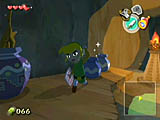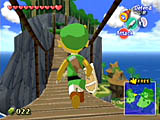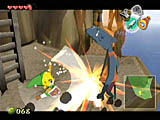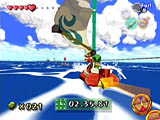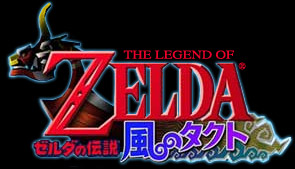
| Platform: GameCube | Publisher: Nintendo of America |
| Genre: Action RPG | Developer: Nintendo of Japan | Format: mini DVD-ROM | Expected Release: February 2003 |
Few games in history have been the subject of as much controversy as The Legend of Zelda for the GameCube. When the game was originally shown at SpaceWorld 2000, gamers were excited to see that a new, darker and mature Zelda game was in the works. A year later, the game was shown again, except now much more lighthearted and cartoonish. Compared to what gamers have been used to, Link looked weird. Needless to say, most people were questioning Nintendo's motive behind this dramatic redesign. Some still feel that the new look for the series will tarnish the Zelda name, or somehow take away the magical feeling that the games always had. Their misconception may prove to be far from the truth.
The first thing most gamers will notice is, of course, the graphics. While the visual style is markedly different from what people were expecting, that's not necessarily a bad thing. The graphics can best be compared to the cel-shading techniques used in many fully polygonal games, though Zelda does things a bit differently. Series creator, Shigeru Miyamoto, has said on more than one occasion that his goal for the game is to create an 'interactive cartoon'. Instead of just applying cel-shading simply for the sake of doing so, Miyamoto intended to make the game play and feel like a cartoon. To some, still shots of the game fail to impress, though Zelda looks much better when seen in action. Though the game doesn’t flow at a liquid 60 frames per second, The Legend of Zelda animates smoothly at a solid 30 fps. Aside from the cartoonish style and respectable frame rate, there are also many small details that add to the experience. Grass dances in the wind and the cloth on both Link and other characters will rustle. When your sword hits a wooden object, splinters will fly off. You can cut down bushes with your sword, like in past games, along with small trees and even break pots. In one of the dungeons, you can also burn ropes holding up a bridge with a torch. These small details and artistic touches come together to create a very believable, and more importantly, interactive, cartoon world.
While not many details on the plot have been released by Nintendo, the basic premise is simple enough. As the game begins, our hero is celebrating his 12th birthday with his family. Link's grandmother gives him the classic green tunic that will soon become the hero's trademark, while he receives a telescope from his sister, Arril. After a short conversation with Arril, the two children hear a girl scream in the distance and rush to the scene only to witness her being carried away by a large bird-like creature. Link goes to intervene, only to see his sister kidnapped as well! Being the noble lad that he is, Link then sets off on his journey to find his sister and bring her home safely. At least that's what one would think, though Link is a mute as ever. For all anyone knows, he's just taking a really long and perilous route to his local Burger King. The locale of the game has yet to be revealed, so gamers are left to wonder if they will be exploring another version of Hyrule or a completely new location. Miyamoto is also being secretive about the inclusion of other key Zelda characters, namely Ganondorf and Princess Zelda herself. One last bit of information that has been revealed though, is that this will be the first game in the Zelda timeline, which is why Link is only 12. Before this version, Link was at his oldest in Ocarina of Time.
The gameplay in The Legend of Zelda is very similar to its two predecessors on the Nintendo 64 (Ocarina of Time & Majora's Mask). Nintendo’s revolutionary Z-Targeting System, the lock-on mechanism that became very popular with other developers after Ocarina of Time’s release, will make a return on the GameCube. While locked-on, Link can circle around an enemy and stay focused on his target in addition to jumping, dodging, defending and performing a leaping attack. The new game will also follow the series tradition of strategic combat, with each enemy requiring a unique technique or tactic to be defeated. While players are able to simply jump forward and attack, a good defense is imperative to your success. Unlike the previous installments, where defeated enemies drop money or hearts, fallen foes will occasionally leave behind a flashing sphere. The sphere cycles between different colors, each hue signifying a different reward. Upon being broken, the sphere drops an item depending on what color it was when you attacked. For example, red gives the player a heart, green will grant a Rupee or Rupees (which is the currency in the series), and so on. At various points during the game, instead of engaging enemies directly, Link will need to avoid being seen as he moves through an area. In addition to simple sneaking, Link can also pick up and hide in a barrel to avoid being caught. Another stealth maneuver is pressing against walls to walk across narrow ledges; similar to Metal Gear Solid, except much cuter. Link can even grab onto hanging ropes and swing in any direction then jump off to get across pits. Miyamoto promises even more situations with unique gameplay elements, such as sailing on your boat to reach new areas, when the game is completed.
The Legend of Zelda’s controls are similar in many ways to the previous 3D installments in the series as well. Attacking with Link's (rather short) sword is done with the A button. Besides a standard attack and the jumping attack, Link can again use his spin attack by holding down the A button to charge energy, and then releasing it. The B button is context-sensitive, and allows you to lift objects, talk to people and many other things depending on your situation. You can also use B to pick up weapons from defeated enemies, such as a large sword or wooden club. In addition to being used as weapons, they can also be used to solve puzzles. The wooden club is flammable, and can be used to light torches if lit by a burning torch, while the large sword can break certain heavy objects that Link's normal blade cannot. Other items, such as bombs, the slingshot and boomerang are assigned to the secondary controller buttons (in this case X and Y). The L button activates the lock-on targeting for battling enemies. The R button is used to crouch, a feature not seen the series since Zelda II. However, the R button can also be used to defend with your shield in certain situations also. While unclear, the R button may be context-sensitive as well. The C analog stick controls the camera while the Z button switches to a 1st person view. Z also helps confused players by giving hints about your situation when the icon flashes on the screen, similar to the ever-annoying Navi from Ocarina of Time.
One surprise feature in The Legend of Zelda is the fact that two players can now play simultaneously. Players will need the use of a Game Boy Advance and a corresponding item in Link's inventory to participate. When this item is activated with a Game Boy Advance connected to the GameCube, a map of your current location will appear on the small screen. Tingle, the constipated fairy from past games, will appear and have access to the same area or dungeon being played on the GameCube. The second player can take control of Tingle via the GBA, while the first player continues to control Link with the standard GC controller. Both Link and Tingle will be seen on the map of both systems, with Link being represented by a triangle, and Tingle by a square. As of this writing, only the A and B buttons seem to function on the GBA. The A button will automatically bring Tingle to Link's location should the other player wander off and become lost and the B button can be customized with one of four actions. So far, we know one is a bomb attack to damage enemies, while the other will cause Link to look in the direction of Tingle. Used maliciously (such as during battle), this second action could severely damage friendships. The bomb attack and the two mystery actions are listed on the GBA with numerals beside their icons, which would mean they could only be used a limited number of times. How players will be able to replenish their stock is unknown at this time.
While many gameplay facets are familiar, there's an element of humor in this upcoming Zelda that’s not seen in the previous titles. The spin attack alone could probably make the most jaded gamer crack a smile due to sheer amusement. In previous games, Link would spin in a complete circle with his sword outstretched to perform this move. This time, however, upon releasing the A button, Link spins out of control for about three seconds in a comical fashion with eyes widened and yelling out (clearly not expecting such power). Afterwards, Link stands still before hunching over for a few seconds; clearly exhausted as he takes a few deep breaths.
This latest incarnation of the beloved series may sound needlessly over-the-top or silly, but gamers with an open mind may be pleasantly surprised. While certainly not what you would expect from a Zelda title, Nintendo and Miyamoto have both stated many times that players need to experience the game before passing judgment. They were right. This new chapter may appear overly whimsical, but remains a true Zelda game with everything players have come to expect: deep gameplay, solid controls, dungeon puzzles, side quests, character interaction and lots of items to find. These traits have always made for a great game, and this incarnation is one all Zelda fans (and everyone else) should be looking forward to in February 2003. ©1987-2002, Nintendo. All Rights Reserved. |
|

